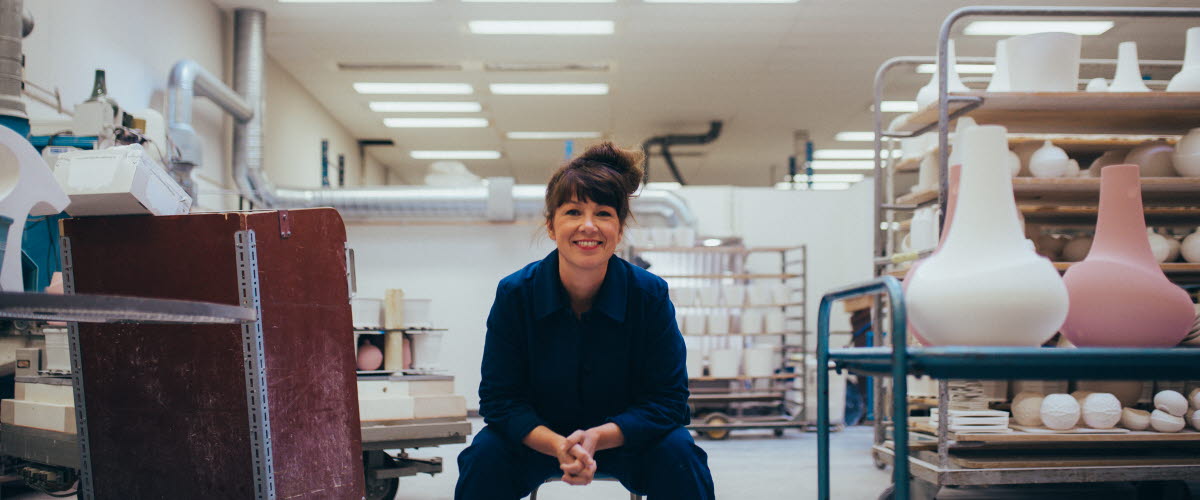Lidköping – for lovers of porcelain and architecture
Swedish design is famous for clean lines, often with inspiration from nature. A perfect example of this is ‘Naturum Victoriahuset’, a building next to Läckö Castle and the south shore of Lake Vänern, and not far from Lidköping. And in the picturesque Lidköping town centre you can learn the history of Rörstrand’s porcelain. With its timeless style it has won the hearts of the Swedish people
Not only is there a café on almost every block, in Lidköping, art and design are natural parts of the townscape. When the pedestrianized main street was upgraded in 2011, the locals got to leave their own mark on their town by creating paintings that were transferred to tiles, which were set in the streets. And at the town square, which by the way is the largest open square in northern Europe, you can see porcelain in the form of artworks by designer Anna Elzer Oscarson and artist Astrid Sylwan.
Porcelain for the Nobel Banquet and commoners alike
Many Swedes associate Rörstrand porcelain with memories of coffee breaks on sunny days at their grandparents’ place. The services made for the mass market as well as the most exclusive ranges have a given place in Swedish design history. Marianne Westman’s series Mon Amie, with its intense blue floral decor, and Swedish Grace by Louise Adelborg, with its subtle pattern of ears of wheat, are two examples that have achieved cult status in Swedish homes. Rörstrand is Europe’s second oldest porcelain brand, and has influenced how the world sees Swedish design ever since it was founded in 1726.
Photographer: Patrik Johansson
Let your creativity flow at Rörstrand Center
In the centre of Lidköping you’ll find Rörstrand Center – a creative hotspot with pottery school, museum, design shops, restaurant and café. A tour of Rörstrands Museum will guide you through 290 years of porcelain manufacture in Sweden. You’ll learn how the ‘white gold’ was produced in Europe’s oldest porcelain factories, and be inspired by the everyday items as well as the sumptuous decorative pieces. Don’t miss the ‘Skaparverkstaden’ (Creator’s Studio), where you can have a go at turning and sculpturing clay, or painting your own cup. Rörstrand’s classic industrial building also contains ‘Formakademin’ (the Form Academy), a knowledge centre where tomorrow’s potters, design modellers and pattern designers are trained.
Anna Elzer Oscarson keeps the tradition alive
Rörstrand Center also contains what is possibly Sweden’s smallest porcelain factory - Porslinsfabriken i Lidköping – which keeps the tradition alive after the large-scale production has moved abroad. By way of close collaboration with contemporary designers like Anna Elzer Oscarson, they produce modern ceramics in a traditional setting. Her collection Dancing Dune is a playful, streamlined series in earthy colours. Also produced here are Svenskt Tenn’s timeless pots, and since 2007 Hackefors Porslin’s fine services, a luxurious addition to Swedish design for nearly a century.
Photographer: ROBERT DAHLBERG
Contemporary architecture in a natural setting
When you visit Lidköping, you simply must get out to Kållandsö, a peninsula just north of town. It’s another chapter in the Swedish design history. Architectural firm White Architects has taken inspiration from the pine forests of the Lake Vänern archipelago, creating the beautiful building ‘Victoriahuset’. With its ribbed wooden façade it almost disappears into the surrounding forest. It’s a striking example of how Swedish architecture is informed by what is around it. The building is dedicated to the Duchess of Västergötland, the Swedish Crown Princess Victoria. The regional government gave her the building on the occasion of her thirtieth birthday in 2007. As you enter the building, the nature-inspired façade follows you in, where you’ll find a nature centre, the Hvita Hjorten restaurant and a hotel.
Outside the building you can see the beginning of Europe’s largest lake archipelago, with some 22,000 islands. The best way to discover the beautiful Vänern archipelago is to paddle along the shoreline in a kayak, but there are also several pleasant walking trails. Experience the diverse birdlife of the peninsula along lakeside meadows, cliffs and a varied cultural landscape, with rock carvings from the Bronze Age. In the east, on the horizon, you can make out the plateau mountain, Kinnekulle.
Photographer: ROBERT DAHLBERG
Läckö – a fairy-tale castle
If the special Victoriahuset building was designed to harmonize with nature, the exact opposite is true of Läckö Castle, proudly positioned on a point overlooking Lake Vänern. Count and Chancellor of the Realm Magnus Gabriel de la Gardie gave the building its characteristic white baroque charm in the second half of the 17th century. With its towers, it seems to come straight from a fairy tale. In summer, visitors from all over the world flock to Läckö to listen to first-class opera in the impressive acoustics of the castle courtyard.
Photographer: Roger Borgelid
Discover Little Castle Garden – a green treasure
On the east side of Läckö Castle is the Little Castle Garden. Every spring the garderners turn the earth by hand, carefully and methodically. And every autumn they build compost piles under the walnut trees. Everything is taken care of, for later use. If you want to learn more about what grows here, the garderners are almost always on site, and are happy to talk about the garden. Everything edible is harvested, and then used in the kitchen of the restaurant Hvita Hjorten, so the restaurateurs Katrin Ljungblom and Stefan Söderholm always have high-quality, super-fresh ingredients to work with.
Photographer: Faramarz


